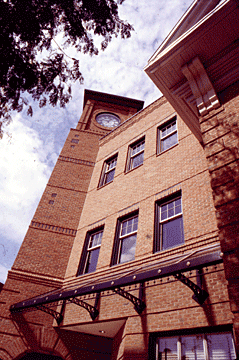 Form follows function is an old adage in architectural design. Today, this
is even more true as designs of new commercial buildings--offices, shopping
centers, banks, restaurants--take on a more sophisticated look. While
big-city architecture still tries to reach the heavens, suburban buildings
are taking on more of a look of what's around them–houses. Form follows function is an old adage in architectural design. Today, this
is even more true as designs of new commercial buildings--offices, shopping
centers, banks, restaurants--take on a more sophisticated look. While
big-city architecture still tries to reach the heavens, suburban buildings
are taking on more of a look of what's around them–houses.
Architects are using more traditional forms and materials, for instance,
Corinthian columns added to the exterior of a modern building. Design
elements of a commercial building are directly responsive to a market image.
And image is what today's market is all about. Environmental aspects and
users' needs, as well as current technological advances, all contribute to
the ultimate design. There is a strong effort to make employees and visitors
comfortable, which makes for increased production.
Many of today’s architects believe that you must give a commercial
building as much light as possible with as much flexibility as possible so
that the building can be rented quickly and adapted for reuse. Clients want
eye appeal with a throwback to classical images. Commercial architecture has
come back to a more decorative look after the sparse designs of the 60's and
70's. Developers are choosing sites for their buildings that offer dramatic
views and increased sources of natural light.
Why has suburban commercial architecture design changed so drastically?
All the architects agree that the public lifestyle is changing and that
includes the environment of the workplace. Everything is on a more human
scale, that is, lower, smaller, and often cozier.
There is a definite trend to using natural materials says Capron. Such
traditional materials as stone, brick, and wood are low on maintenance as
well as more comfortable and soothing in appearance. Materials can also
enhance the image the architect is trying to obtain. The pre-cast concrete
and glass block elements of some buildings support an image of solidness.
The brick banding on the exterior helps to give the building a more human
scale and visually delineates the various levels. Also, the standing seam
roof helps to give the hotel a look of a residential building with an extra
added feature of low maintenance. Materials can be used to vary the scale of
the building and make it complement or blend with those around it. This is
very important in a corporate center like Great Valley where buildings are
relatively close together.
All the architects must consider certain factors when designing their
buildings. First and foremost, they must be responsive to their clients
needs and desires. The function of each building must be considered, but
also must the site on which it rests. Strict budgets are always a factor
today. Even though natural materials, like fieldstone, are more expensive,
they give the building more ultimate value. The extra added feature is low
maintenance, which keeps future costs down.
Most architects agree that peaked and gabled roofs are the most friendly.
n fact, the most successful projects are the ones that are the most
residential looking. Another important part in new building design is the
traditions and history of the area.
Existing buildings can be harder to work with. For example, an owner
might chose to go with a more traditional turn-of-the-century look, changing
the atmosphere by adding brick paving and new light fixtures, planters and
benches, and increased landscaping.
Ultimately the game plan of the client is the most important. The
client's taste and even township restrictions and codes influence the shape
and look of commercial buildings today.
|
